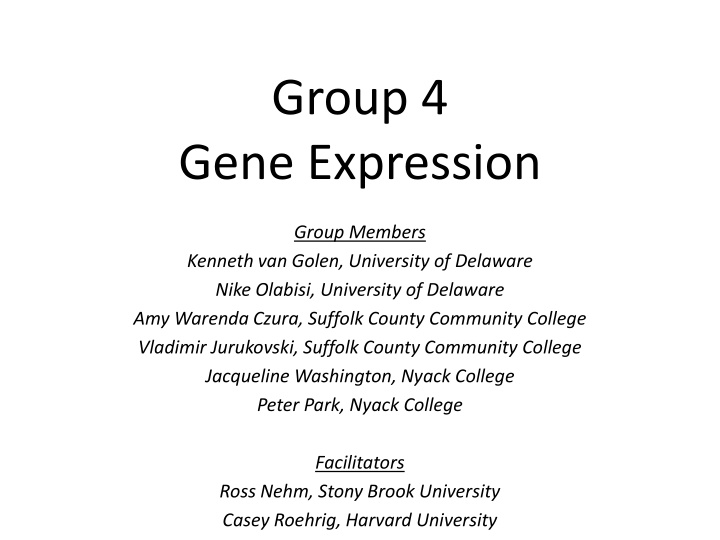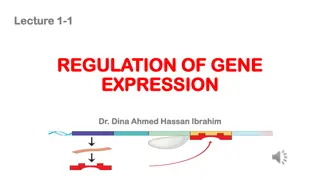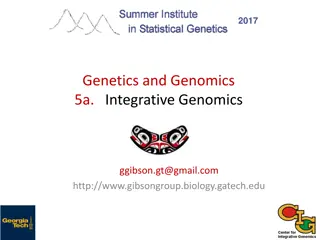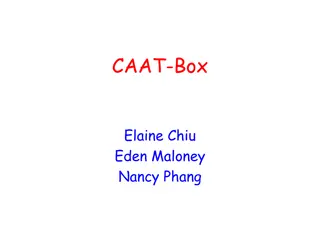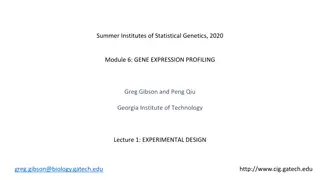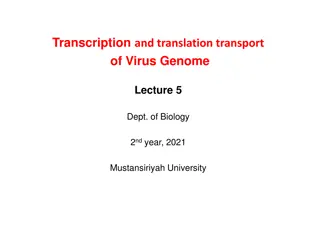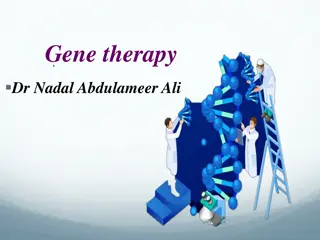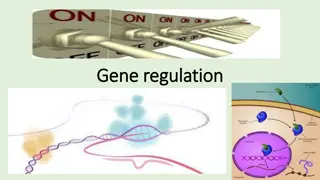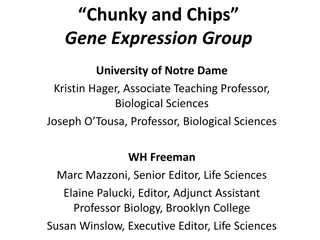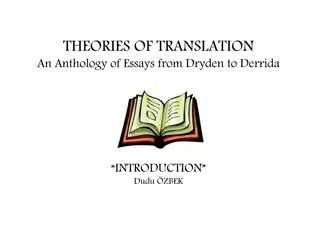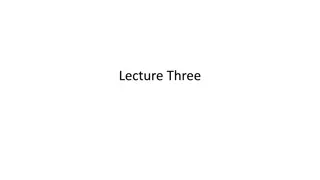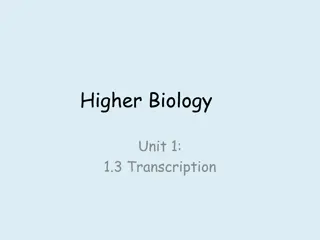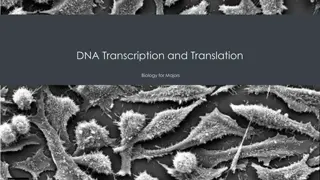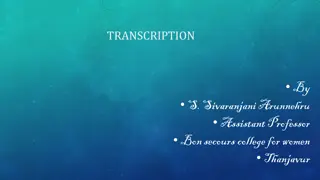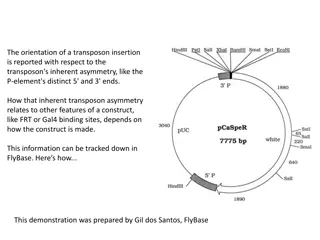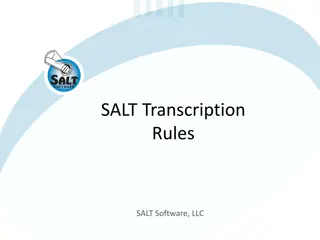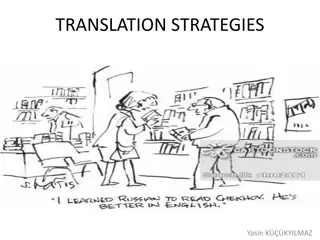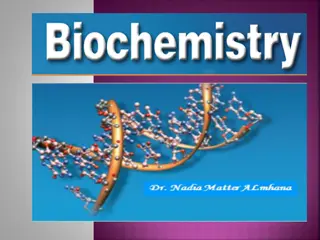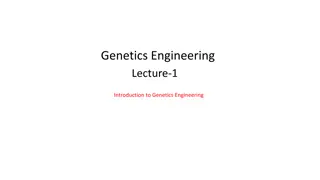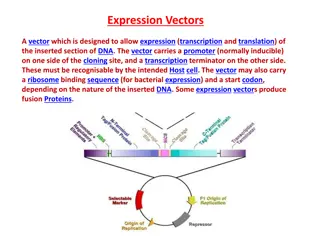Introduction to Gene Expression: Basic Concepts in Transcription and Translation
Explore the foundational concepts of gene expression including transcription and translation processes, genetic mutations, and their impact on protein structure and function. Learn to define genes, outline central dogma steps, and understand the relationships among DNA, genes, RNA, and proteins. Practice transcribing DNA sequences to mRNA and predicting mutation effects, all essential for introductory biology studies.
Uploaded on Oct 01, 2024 | 2 Views
Download Presentation

Please find below an Image/Link to download the presentation.
The content on the website is provided AS IS for your information and personal use only. It may not be sold, licensed, or shared on other websites without obtaining consent from the author.If you encounter any issues during the download, it is possible that the publisher has removed the file from their server.
You are allowed to download the files provided on this website for personal or commercial use, subject to the condition that they are used lawfully. All files are the property of their respective owners.
The content on the website is provided AS IS for your information and personal use only. It may not be sold, licensed, or shared on other websites without obtaining consent from the author.
E N D
Presentation Transcript
Group 4 Gene Expression Group Members Kenneth van Golen, University of Delaware Nike Olabisi, University of Delaware Amy Warenda Czura, Suffolk County Community College Vladimir Jurukovski, Suffolk County Community College Jacqueline Washington, Nyack College Peter Park, Nyack College Facilitators Ross Nehm, Stony Brook University Casey Roehrig, Harvard University
Gene Expression: A Basic Overview Context: Intended for Introductory Biology (first course of a two semester series). The topic should be covered within one class week; 3 lecture hours. The teachable unit will be taught in the middle of the course after introduction to chemistry, proteins, and enzymes.
Learning Outcomes Learning Goals The students should be able to: Define and illustrate the basic structure of a gene. Outline the basic steps of the central dogma. Define and explain the process of transcription. Compare and contrast prokaryotic and eukaryotic transcription. Apply genetic code to translation. Define and explain the process of translation. The students should be able to: Demonstrate knowledge of the relationships among DNA, genes, RNA and proteins. Know the detailed mechanisms of the processes of transcription and translation.
Learning Outcomes Learning Goals The students should be able to: Define and illustrate the basic structure of a gene. Outline the basic steps of the central dogma. Define and explain the process of transcription. Compare and contrast prokaryotic and eukaryotic transcription. Apply genetic code to translation. Define and explain the process of translation. Describe the various types of genetic mutations. Predict the effect of mutations on protein structure and function. The students should be able to: Demonstrate knowledge of the relationships among DNA, genes, RNA and proteins. Know the detailed mechanisms of the processes of transcription and translation. Understand how genetic mutations impact protein function.
Lets assess your knowledge of the basic concepts of transcription and translation from the previous lesson that applies to today s topic.
Lets start with a piece of DNA Coding strand 5 ATGCGTTTAGAATGA 3 3 TACGCAAATCTTACT 5 Template strand
Writing Activity: Given the following sequence on your handout, transcribe the sequence of the mRNA (1 minute) Template strand of DNA 3 TACGCAAATCTTACT 5 mRNA ?
CLICKER Question: Choose your answer Template Strand of DNA 3 TACGCAAATCTTACT 5 mRNA ? A. 5 UACGCAAAUCUUACU 3 B. 3 UACGCAAAUCUUACU 5 C. 3 AUGCGUUUAGAAUGA 5 D. 5 ATGCGTTTAGAATGA 3 E. 5 AUGCGUUUAGAAUGA 3
3 TACGCAAATCTTACT 5 Key concepts nucleic acids have polarity mRNA transcript is complementary and antiparallel to the DNA template strand. DNA RNA C G G C T A A U
CLICKER Answer 3 TACGCAAATCTTACT 5 A. 5 UACGCAAAUCUUACU 3 B. 3 UACGCAAAUCUUACU 5 C. 3 AUGCGUUUAGAAUGA 5 D. 5 ATGCGTTTAGAATGA 3 E. 5 AUGCGUUUAGAAUGA 3
CLICKER Answer Explanation 3 TACGCAAATCTTACT 5 A. 5 UACGCAAAUCUUACU 3 Misconception: RNA is just DNA with U instead of T
CLICKER Answer Explanation 3 TACGCAAATCTTACT 5 A. 5 UACGCAAAUCUUACU 3 Misconception: RNA is just DNA with U instead of T B. 3 UACGCAAAUCUUACU 5 Misconception: Same as A, but also polarity is reversed
CLICKER Answer Explanation 3 TACGCAAATCTTACT 5 A. 5 UACGCAAAUCUUACU 3 Misconception: RNA is just DNA with U instead of T B. 3 UACGCAAAUCUUACU 5 Misconception: Same as A, but also polarity is reversed C. 3 AUGCGUUUAGAAUGA 5 Misconception: Sequence correct but polarity is reversed
CLICKER Answer Explanation 3 TACGCAAATCTTACT 5 A. 5 UACGCAAAUCUUACU 3 Misconception: RNA is just DNA with U instead of T B. 3 UACGCAAAUCUUACU 5 Misconception: Same as A, but also polarity is reversed C. 3 AUGCGUUUAGAAUGA 5 Misconception: Sequence correct but polarity is reversed D. 5 ATGCGTTTAGAATGA 3 Misconception: RNA is the exact complement of DNA
CLICKER Answer Explanation 3 TACGCAAATCTTACT 5 A. 5 UACGCAAAUCUUACU 3 Misconception: RNA is just DNA with U instead of T B. 3 UACGCAAAUCUUACU 5 Misconception: Same as A, but also polarity is reversed C. 3 AUGCGUUUAGAAUGA 5 Misconception: Sequence correct but polarity is reversed D. 5 ATGCGTTTAGAATGA 3 Misconception: RNA is the exact complement of DNA E. 5 AUGCGUUUAGAAUGA 3 Correct!
Given the mRNA we transcribed on the handout, assume the sequence is in frame and translate the amino acid sequence. 5 AUGCGUUUAGAAUGA 3 Think-Pair-Share (1 min think, 1 min share) Compare with neighboring groups (1 minute) Is there anything else you need to do this?
Genetic Code located in the middle of the table: share with your neighbor!
Given the following mRNA, translate the amino acid sequence. 5 AUG CGU UUA GAA UGA 3 What did you get?
Given the following mRNA, translate the amino acid sequence. 5 AUG CGU UUA GAA UGA 3 Did you get this? Met Arg Leu Glu Stop Methionine Arginine Leucine Glutamic Acid Stop codon
Group Activity Directions: Form three groups at your table and have each group work on one of the following base changes to the original DNA sequence on your handout. After making the DNA change transcribe and translate the new sequence. (2 minutes) Group #1: Change the 8th base from A to C #2: Change the 9th base from T to C #3: Change the 11th base from T to A
Group 1 Change the 8th base to C Template DNA 3 TAC GCA AAT CTT ACT 5
Base changed from A to C Group 1 outcome Template DNA 3 TAC GCA ACT CTT ACT 5 mRNA
Base changed from A to C Group 1 outcome Template DNA 3 TAC GCA ACT CTT ACT 5 mRNA 5 AUG CGU UGA GAA UGA 3 This base becomes G
Base changed from A to C Group 1 outcome Template DNA 3 TAC GCA ACT CTT ACT 5 mRNA 5 AUG CGU UGA GAA UGA 3 Protein Met Arg Stop The new codon is a stop codon This base becomes G Original Protein Met Arg Leu Glu Stop
Group 2 Change the 9th base to C Template DNA 3 TAC GCA AAT CTT ACT 5
Group 2 outcome Base changed from T to C Template DNA 3 TAC GCA AACCTT ACT 5 mRNA
Group 2 outcome Base changed from T to C Template DNA 3 TAC GCA AACCTT ACT 5 mRNA 5 AUG CGU UUGGAA UGA 3 This base becomes G
Group 2 outcome Base changed from T to C Template DNA 3 TAC GCA AACCTT ACT 5 mRNA 5 AUG CGU UUGGAA UGA 3 Protein Met Arg Leu Glu Stop The new codon does not change the amino acid This base becomes G Original Protein Met Arg Leu Glu Stop
Group 3 Change the 11th base to A Template DNA 3 TAC GCA AAT CTT ACT 5
Base changed from T to A Group 3 outcome Template DNA 3 TAC GCA AAC CAT ACT 5 mRNA
Base changed from T to A Group 3 outcome Template DNA 3 TAC GCA AAC CAT ACT 5 mRNA 5 AUG CGU UUG GUA UGA 3 This base becomes U
Base changed from T to A Group 3 outcome Template DNA 3 TAC GCA AAC CAT ACT 5 mRNA 5 AUG CGU UUG GUA UGA 3 Protein Met Arg Leu Val Stop The new codon changes the amino acid from Glutamic Acid to Valine This base becomes U Original Protein Met Arg Leu Glu Stop
CLICKER Activity (30 seconds): All sequence changes in DNA genes are deleterious (harmful) to protein structure. A. True B. False
A change in the DNA is called a mutation. Summary Nonsense Mutation Silent Mutation Missense Mutation Original DNA AAT AAT CTT Mutation ACT AAC CAT mRNA UGA UUG GUA Leu Stop Leu Leu Glu Val Protein
Example of a missense mutation with a significant biological consequence Sickle-cell disease is the result of a single amino acid substitution
Homework Due Next Class: 1. Use the DNA sequence on your handout and make as many single base mutations that you can that will result in the creation of: A. Nonsense mutations B. Silent mutations 2. Predict what would happen during translation if the third base was deleted from the DNA sequence? Next topic: Mutations - Altered Genes
Conclusions of Instructional Tidbit Strategy Students have been introduced to genetic mutations though different forms of active learning activities; clicker questions, group activities and homework to account for diversity in learning styles Formative assessment; post test of transcription and translation built on prior instruction was incorporated into the learning experience, with guidance and feedback from instructors addressing misconceptions After these learning activities, students should now be able to describe various types of genetic mutations We will transition to the next topic to complete the learning goals and outcomes of this unit, after which the students should be able to predict the effect of mutations on protein structure and function
